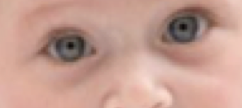Award Winning Author
Face Reading with Before & After Photos
Blue Veins (Sugar Bug) Across Your Child’s Nose Bridge
Support your Baby’s Immunity
When blue veins show across your child’s nose bridge, she’s not at her best according to Traditional Chinese Face Reading. These veins, as we see below, are found in the very young whose diets are typically high in sweets and other inflammatory foods. This explains their Japanese name, kanmushi, or “sugar bug.”

An infant with this facial indicator is often more congested, immune challenged and irritable than is a child without such visible veins. Or, to say it another way, the next time your child is colicky or crotchety, look for this blue “bug.”
For your baby’s comfort, regard visible nose bridge veins as a barometer to help regulate her well-being. By minimizing digestive stress and congestion, you support her immune system and reduce congestion.
At Any Age, Veins Swell after a Blood Sugar Spike
Whether we’re 6 months or 60 years old, our veins are stretchable and temporarily enlarge after a blood sugar spike. (see Varicose Veins and Blood Sugar Connection.) Because children have more opaque skin, it is easer to see this engorgement. This transparency fades by the age of four or five and underlying veins are obscured.

Here is the same baby with her twin and it’s curious that while their sugar bugs vary in detail, they appear in the same location (enlarge your screen for a closer look). So why, you may wonder, does a vein triggered by a digestive challenge display on the nose bridge and not the earlobe or big toe?
Seeing Under Thin Skin
There are two reasons for a sugar bug’s location. First, our thinnest skin, a mere .5 mm, is located around the eyelids so it is there that we can more easily see under the skin. Second, the nose bridge is one of several places to read digestive health according to Traditional Chinese Medicine (TCM). For additional digestive support information using TCM, see my Earth Element Blogs.
You’ll find that it is easiest to spot kanmushi on toddlers with a fair complexion. That’s because skin with a darker complexion is thicker, more compact and, therefore, less opaque. A plus of darker pigmentation is that as one ages, wrinkles are also less visible.
Sugar Bug = Sugar Blues
Does it seem that your baby is always blue across her nose bridge? Experiment by decreasing inflammatory foods. Then watch the meltdowns and excess mucus recede as your sweet-natured baby regains inner balance.
But, you may ask, how do you change the diet of a breastfed infant? You change the mother’s diet!
From infancy, my three children had normal colored skin across their nose bridges. Until, that is, for a day or so after Halloween or a birthday party. Then those kanmushi blossomed and my kids would be full of mucus and off-kilter. Yes, the sugar bug spells the sugar blues.
Optimal Diet
To prevent sugar bugs, ideally during pregnancy and breastfeeding you’ll have followed a healthy diet. Then you’ll extend the same to your child. Favor whole foods that are freshly prepared and make sure meals are nutritionally balanced. For more details, see Clear Up Your Complexion.
Remember that fruit and fruit juice are simple sugars, so in addition to limiting sweet treats, also monitor your child’s fruit consumption. Dilute juices and offer as an occasional treat rather than a daily beverage. See Baby’s First Foods.


My 6 month old grandson was born with this blue vein on his bridge. He is a calm baby and is exclusively breastfed. Are some babies not affected by it?
A traditional view is that there’s a blood sugar issue with the mother’s diet if your grandson had it from birth.
My boy is 2 and has had this vein since I can remember. He has never slept through a night and has extreme issues with food. He was exclusively breastfed but at 12 months he started to refuse other foods. Our dietician and other professionals are dumbfounded. ALL he eats is certain specific crisps and milky bar buttons and he only drinks water and breastmilk. I’m wondering if he has an intolerance and now associates food with pain? Is there anything you can recommend please? I would really appreciate any help, thank you
I’m so sorry for your troubles with your son. What a worry for you. I obviously can’t advise. But perhaps look for a physician who practices integrative or functional medicine. If your current team isn’t getting at the root of the problem, explore your options. Good luck.
Hi Rebecca,
My son will be 2 in May of this year. He’s had two vertical blue lines at the top of his nose (almost right between his eyes). The doctor has told me it’s nothing to worry about but they will not go away. Should I be worried? Have you seen vertical sugar bug lines before? He did NOT handle vaccines well as another person noted.
I agree, not to worry. If I were you, simply notice. What in his diet (or lifestyle) seems to cause these lines to increase and what causes them to decrease?
My third baby is the only one with a “sugar bug” and he has been sensitive and irate from the start. Perhaps this helps explain his unhappiness. But my diet is super clean so I feel at a loss. Thank you for this insight. So many medical sources would write this off.
Kate…how frustrating for both you and your baby. You say that your diet is clean, that’s wonderful; and let’s look a little deeper.
Here’s my definition of a clean diet: it is pleasurable, easily digested and provides your energetic needs. Perhaps the diet that served you well for your first two pregnancies might need adjusting? Perhaps your digestive organs need some extra support? Or perhaps a favorite staple is no longer well tolerated? I invite you to look at my complexion blog for suggestions.
Experiment with those ideas and let his sugar bug be your barometer. In traditional Asian medicine, a nursing baby’s digestive health is first addressed by adjusting the mother’s diet.
And while diet is critical, we know it is but one piece. Perhaps there’s extra stress given the pandemic? Or some other cause and condition? In my consultations, I use face reading and other information to help address the root of the problem.
A blue vein is also a sign of MTHFR gene mutation. Parents, please research MTHR and carefully evaluate vaccinations as MTHFR kids do not handle vaccinations well.
Olya, thank you for this very important update.
Can someone please direct me to more information about being sensitive to vaccinations?
Thanks A.
Consider this title by Forrest Maready: Crooked: Man-Made Disease Explained: The incredible story of metal, microbes, and medicine – hidden within our faces
My son is 7 and his sugar bug vein is still visible but he is healthy. I do notice that he is sensitive to sugar. Is that a bad thing?
We are all “sensitive” to what we ingest in that our bodies respond. To thrive, aim to eat whole foods and nutritionally balanced balanced meals. When we eat refined foods (like sugar) or too many carbohydrates it results in an undesirable blood/sugar reaction. To the best of your ability, limit simple sugars from you son’s diet and note the results 🙂
My child is 1 month old, exclusively breastfed and has a blue vein across her nose which was visible from day 1 of life. She’s also very sweet tempered and sleeps easily. Basically everything that the blue vein is supposed to predict against. :/
We rejoice! May all babies (and all of us) be healthy. A blue vein is just one indicator, it’s not the whole enchilada. Down the road, you might pay attention to the vein and note if it reflects any patterns (i.e. more visible when she has more mucous and does your/her diet correlate).
My little girl is nearly 5 months and I would agree, she has a sugar bug vein. But she is happy and well. How bogus of you to make such outrageous claims.
How we rejoice in your daughter’s good health. Thanks be! I’m simply reporting what over 2000 years of traditional Chinese Medicine has observed: a blue vein across a young child’s nose bridge suggests an underlying imbalance–often related to overconsumption of carbohydrates. But here is a suggestion: you might consider moderating your diet (if she is breast fed) and see if you note a change in her “sugar bug.” Do let us know your results.
Not all individuals reading what you have written about the sugar bug vein will take it so personally, as if you are telling people what their babies/infants are like. All you’re doing is providing info through research documentation about it (the sugar bug). I appreciate your time in doing so and will not refer to you as targetting my child as if you are offending her or me. Thanks for the reading.
Thank you. Yes, my intent is to provide legitimate information that others might find of benefit. May we all enjoy optimum health.